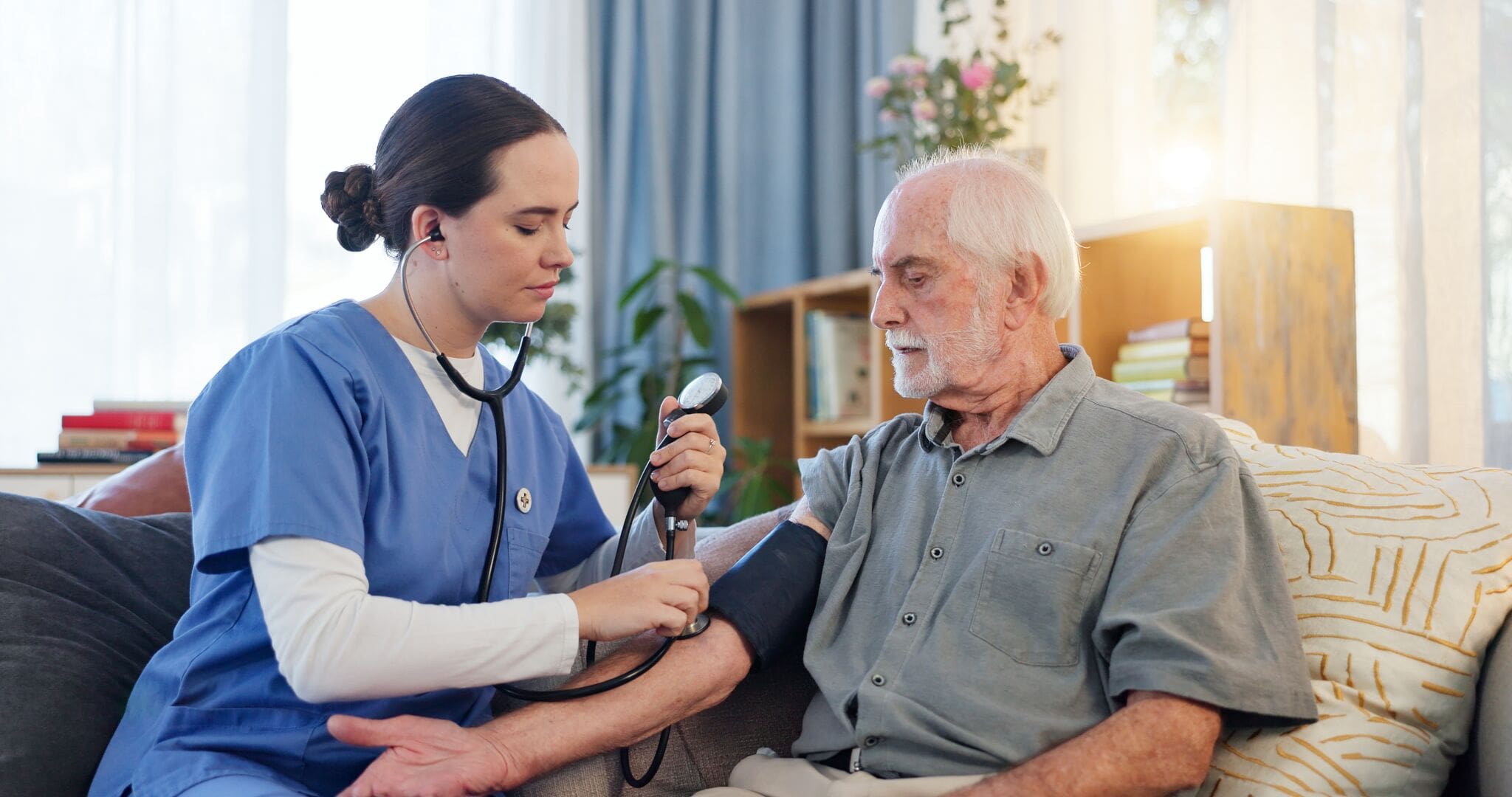In this article
Fire safety is a vital component of workplace health and safety across a range of industries and settings. In the residential care sector, a robust fire safety policy is especially important due to the vulnerable nature of the residents.
Care homes present unique challenges that require careful consideration when making a fire evacuation plan as residents may struggle to understand what is happening or be unable to leave unaided in the event of fire. This could be due to physical problems, a disability or a cognitive impairment.
Care homes must provide thorough fire training for everyone as all employees have a role to play in fire prevention and ensuring safe working practices. Each care worker must be willing and able to support their residents in the event of a fire breaking out.
Regular, effective training empowers care workers with the knowledge and tools they need to react safely in an emergency and take the necessary steps to minimise risks and improve response times during fire related incidents.
The Importance of Fire Safety Training in Care Homes
The London Fire Service highlights 3 key areas where care homes tend to fall short:
- Inadequate staffing (especially at night) to support a safe evacuation
- Lack of practice
- Out of date plans and/or a failure to personalise evacuation plans
In the event of a fire, the actions of all staff are likely to significantly influence the success of the evacuation.
Robust fire safety training is especially important in care homes due to:
- The vulnerable nature of the residents
- The fact that some residents are immobile or unable to assist with their own evacuation
- The high turnover of staff that the sector is known for which mean that there may be staff on-site who are unfamiliar with the building layout or fire protocol
- The cultural diversity of care workers, with many having English as a second language
It is a legal requirement for a competent person (such as a manger or health and safety consultant) to undertake a fire risk assessment in a care home and ensure the care home has a fire safety policy. Fire safety training should take into account the findings of the risk assessment.
Good recordkeeping is also vital as when the fire alarm sounds, it is necessary to know exactly who is on site (staff, residents, visitors and any external contractors) to make sure that all of these people are accounted for.
Key Components of Effective Fire Safety Training Programs
The key components of effective fire safety programs include:
- Understanding fire hazards and prevention
- Use of fire safety equipment
- Evacuation procedures
- Role of fire wardens

Understanding fire hazards and prevention
Many of the same fire hazards exist across most buildings and homes, however, effective fire training in care homes should contain industry specific information.
Fire training programs should outline the most common fire hazards in care homes, including:
- Electricity/ electrical appliances
- Cooking/ cooking oil fires
- Chemicals used in cleaning
- Oxygen tanks used for residents who require oxygen therapy
- Smoking
Effective training programs should provide examples of proactive and practical measures that can be taken on a daily basis to reduce the chance of a fire breaking out, such as only smoking in designated areas, never wedging fire doors open, practicing good housekeeping, not overloading sockets and routinely checking electrical equipment for wear and tear or damage.
Use of fire safety equipment
Small fires can be tackled by staff if they feel safe to do so. Care homes are required to have different types of equipment on site to detect, contain and fight fire. Care home staff should receive instruction and training on the following:
- Fire extinguishers – including their location, how to use them and which extinguisher is suitable for which type of fire
- Understanding the PASS method – (Pull the pin, Aim the extinguisher nozzle, Squeeze the lever, Sweep from side to side)
- Fire blankets – including location (usually in the kitchen/cooking areas), how and when to use them
- Fire alarms, smoke/ heat detectors and sprinkler system – training should briefly explain what each fire detection/ suppression system is and how it works. It should also cover the importance of regular testing and the importance of not tampering with devices
- Break glass points – staff should know where to find these in the building and how to use them to raise the alarm if they discover a fire
- Fire doors – when closed, fire doors can contain fire for an amount of time to slow down the spread, protecting property and life. Training should cover the dangers of wedging fire doors open and the potential consequences if they are caught doing so (including fines)
Evacuation procedures
If the fire alarms sounds during a shift, it is vital that everyone can exit safely in a timely manner. To do this, everyone in the care home needs to be prepared and understand their individual role and responsibilities.
This area of training should touch on:
- What the fire alarm sounds like
- Contacting the emergency services
- What to do when the fire alarm sounds (stop what you are doing, ensure corridors are clear, close fire doors behind you, fire team to go to internal meeting point etc)
- The importance of staying calm during an emergency
- Where emergency exits are located
- Where the designated meeting point is
It is also useful to cover common mistakes people make such as stopping to collect personal belongings, running or shouting as this can waste time, increase panic and lead to mistakes being made.
Good fire training programs should cover both what to do and what not to do.

Role of fire wardens
Everyone who works within the care home has a responsibility for fire safety and should work as a team to help achieve a safe environment for all. Each workplace also has to appoint dedicated fire wardens.
A fire warden (also called a fire marshal) has additional responsibilities for fire safety at work and may require more comprehensive training as their role may include:
- Helping those on the premises to leave
- Performing a sweep of the building to ensure everyone is out
- Using firefighting equipment (only if it is appropriate and safe to do so)
- Liaising with fire and rescue service when they arrive
- Shutting down any dangerous equipment that may pose an additional hazard
- Taken on a supervisory role during a fire related emergency
- Conducting a roll call
Effective fire safety training programs should:
- Be interesting and engaging
- Contain factually accurate information
- Contain some statistics and real world examples
- Use clear, simple language and easy to understand explanations
- Have some way to measure understanding and effectiveness (for example a quiz or test at the end)
- Be ongoing
Fire safety training can be done online, in person or a mix of both, however, the most effective fire training programs will contain a mixture of classroom/online learning plus a practical, hands on component.
Fire Drills and Emergency Preparedness
Regular fire drills are vital as they allow staff and residents to experience what may happen when the fire alarm goes off in a safe environment. They also allow everyone to familiarise themselves with the sound of the alarm, the location of evacuation routes and fire exits. Practice fire drills also allow for any gaps in skills, knowledge or resources to be identified.
Fire can spread very quickly through a building and therefore it is important that a full evacuation can be done as quickly and safely as possible, preferably in just a few minutes.
The amount of time it takes to evacuate a care home will be influenced by a number of factors, such as:
- The size and layout of the building
- The number of residents
- The mobility of the residents
- How cooperative residents are likely to be (for example if they have cognitive issues or disabilities)
- The number of staff available to help move residents
- Whether there is specialist medical equipment to disconnect/ move
- The level of training the staff have received
Practice fire drills can be timed to assess how quickly they can be done and to try to reduce this to the shortest time possible.
Simulated emergency scenarios also have a role to play within fire safety within care homes. A simulated scenario allows staff to practice responding to different types of challenging situations, for example:
- Evacuating immobile patients using evacuation aids (such as wheelchairs or evacuation chairs)
- Practicing night time evacuations
- Evacuations using minimum staff levels
- What to do in the event of discovering a blocked fire exit
- How to respond to a confused or agitated resident or one who refuses to leave
Communication and Coordination During Fire Emergencies
During fire emergencies, effective communication and a collaborative effort increase the chances of everyone being safely evacuated. A quick, effective response may also reduce damage done by the fire to the building and surrounding areas. Both internal communication and external communication are vital in emergency situations.
Internal communication includes
- Staff speaking to one another about the evacuation plan, helping to move residents and sweep corridors
- Employees inside and outside the building staying in touch via walkie talkie or phone
- A staff member (usually a fire warden) who is in charge of the roll call. This means checking that the number of people who are listed as on site corresponds with the number of people present at the meeting point
External communication
- A designated person should call emergency services and communicate to everyone that this has been done
- A fire warden should act as a liaison with the emergency services once they arrive
- If anyone is missing and unaccounted for after the roll call/ head count this information needs passing onto fire and rescue personnel to enable them to go inside and locate them
Tailored Training for Different Staff Roles
People may be exposed to different fire risks in care homes depending on their role meaning that it is important that employees receive both basic training and more role-specific training.
Examples of tailored training for different staff roles:
- Caregivers and nurses – training should focus on assisting residents with cognitive and mobility challenges, how to use evacuation aids and for nurses how to disconnect or transport medical equipment during emergency evacuation
- Housekeepers and cleaners – training should focus on chemical safety and storage, the need to keep store cupboards locked if they contain flammables (such as linen or cleaning products) and the importance of good housekeeping and keeping escape routes and exits clear of stored items, rubbish or other debris
- Maintenance workers – fire training should focus on electrical safety and the importance of routine inspection and testing and working safely around electricity to reduce risk
- Kitchen and catering staff – cooking fires are the most common cause of care home fires. Kitchen staff should be trained on fire prevention techniques such as never leaving cooking unattended, taking care when frying with oil, regular cleaning to remove grease build up etc

The Role of Refresher Courses and Continuous Learning
Fire safety training should always be integrated into the onboarding process. However, regular refresher training should also be conducted in order to:
- Prevent people from becoming complacent
- Reflect the changing face of the workplace or changes in working practices
- Stay up to date with best practice and any changes in legislation
- Keep training relevant and in line with new safety standards or innovations in fire safety equipment
Embedding a culture of continuous learning and embracing change can improve accountability and encourage a sense of pride and responsibility amongst the workforce. Fire safety training should never be considered as a one-off course but as a continuous learning process.
Technology-Enhanced Fire Safety Training
Technology is revolutionising the way training can be delivered both inside and outside of the workplace. This includes:
- Online learning modules that can be done from anywhere with a device and internet connection
- Online training platforms that allow employers to track their employee’s progress, download certificates of completion etc
- Interactive quizzes, drag and drop or point and click exercises
- Virtual reality simulations that allow people to have a safe, immersive experience of an emergency situation which can make them feel more prepared for an actual fire
Some care homes may find it useful to use mobile apps, online shared calendars or other scheduling software to share safety updates and schedule fire drills and training sessions with their workforce.
Measuring the Effectiveness of Fire Safety Training
Fire safety training is only useful if it teaches participants the correct information and if they are able to understand and retain this information for future. It is important to find ways to measure and evaluate the efficacy of fire safety training and to act on any issues that arise, for example:
- Allow participants the chance to ask questions to show they are engaged and interested
- Use tests and quizzes to check knowledge and that people have been paying attention
- Use practical and hands on activities to engage workers
- Ask for feedback during or after the session
- Provide ways for attendees to leave anonymous feedback, tips or suggestions (people may be more comfortable providing honest feedback anonymously)
As discussed in the previous section, many workplaces are now opting to use online training portals where they can track the progress of staff in terms of their training and ensure it is completed by set deadlines. These results can also be used to identify staff who require additional training or those who are excelling and may want some additional responsibilities, for example becoming a fire warden.
During fire safety drills, managers and fire wardens can assess the efficacy of fire safety training and make note of any skills gaps or areas of improvement by observing the actions of workers, timing how long the evacuation takes and asking for feedback afterwards. It is very important to act on any points that are raised during fire drills as soon as possible to prevent the same issues occurring during a real event where the consequences could be far more serious.
Conclusion
Fire safety is vital across all industries and workplaces. In the care sector, the vulnerability of the residents presents unique challenges to staff in the event of an emergency. It is vital that all care workers are properly trained and well prepared to deal with emergency situations, including fires. This can be achieved through regular training, hands on practice, access to resources and embedding a culture within the care home of accountability and respect for workplace health and safety.






